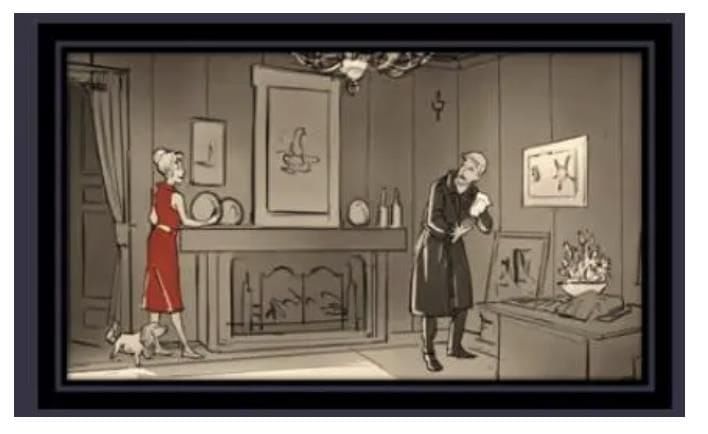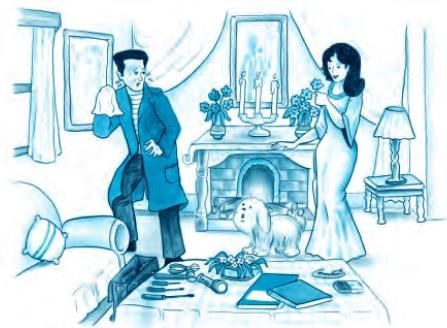Long Answer Questions: A Question of Trust | English Class 10 PDF Download
Q1: How did the lady in red manage to outsmart and out manoeuvre the other thief, Horace Danby, by robbing the safe without leaving a single fingerprint?
Ans: The lady in red was also a thief like Horace Danby. But it was the lady in the red dress who outmanoeuvred and outwitted Horace. No doubt, Horace did his job quite professionally. He worked hard to find out the necessary details about the location of the house and the position of the key and the safe.
But, Horace proved to be a novice in judging the young lady. The young lady acted with so much confidence and in such a convincing manner that she could easily pass off as the lady of the house. Horace Danby became a mere puppet who danced to the tune of the lady.
When caught red-handed, he pleaded her to let him go. The young lady exploited his confusion and fear of going to prison fully. She made Horace open the safe. The unsuspecting Horace was made to believe that he was working for the lady of the house. So he opened the safe without putting on his gloves.
He gave the jewels to the lady leaving his fingerprints on the safe. So he was found out and arrested. Naturally, the young lady in red proved far smarter. 
Q2: Horace Danby represents such people who adopt the wrong ways to fulfil their wishes. What values would you like such people to imbibe to reform themselves?
Q3. Horace stated that he robbed only those who had a lot of money. Was he really a threat to society? Did he lack the qualities of a good citizen? Discuss the values he needs to imbibe to lead a path of righteousness in 100-120 words.
Ans: Horace was not a major threat to society, as he only targeted wealthy individuals and did not cause any physical harm during his robberies. Although he was seen as a good citizen, his actions revealed a lack of honesty and integrity. He stole for personal gain rather than out of malice. To lead a more righteous life, Horace should adopt values such as respect for others' property, self-discipline, and a commitment to hard work. He must recognise that wealth obtained through dishonest means is fleeting and can lead to negative consequences. By striving to meet his needs through effort, he can achieve a life of dignity and positively contribute to society.

Q4: ‘Honour among thieves’ is considered a popular code. Examine A Question of Trust as a story woven around this code.
Ans: 'Honour among thieves’ is a popular code among thieves to protect themselves from each other. Thieves follow his code and they are not supposed to cheat each other and double cross against themselves. According to this, the thieves help each other. In the story, 'The Question of Trust’, the main protagonist is very careful regarding his theft conducted once a year. But the lady in red, who is thief herself, does not follow the code and breads the code of honour that exists between them. Horace mistake the lady thief as the owner of the house and opened the safe for her so that she could have those jewels. This resulted its him going to the prison for the first time. Horace felt betrayed and his trust broken.
Q5. Horace Danby requested the lady to forget what she saw. Was Horace afraid of being caught? Did he lack the courage to accept his crime publicly? Explain the values one must imbibe to accept one’s mistake in 100-120 words.
Ans: Yes, Horace was afraid of being caught and lacked the courage to face the consequences of his actions. Although he was perceived as a good man, his fear led him to ask the lady to forget what she saw instead of admitting his mistake. This highlights his failure to accept responsibility. To live a righteous life, one must embrace values such as honesty, accountability, and courage. Accepting one’s mistakes and learning from them is essential for personal growth. Horace needed the strength to confront the truth and make amends, as it is through self-reflection and honesty that individuals can truly improve.
Q6. “Horace had some hope because she seemed to be amused at meeting him.” Why did Horace feel so? Did he consider the young lady compassionate towards him? Did he find her free from bias? Discuss the values Horace should have imbibed understanding of the person in 100-120 words.
Ans: Horace felt hopeful because the young lady seemed amused and kind, leading him to believe she might spare him from punishment. He misinterpreted her politeness as compassion and thought she was unbiased. However, Horace failed to grasp her true nature. He needed to learn the value of being more discerning and not swayed by superficial charm. It's crucial to evaluate people based on their actions rather than initial impressions. Horace should have recognised the importance of seeing beyond appearances and trusting his own judgment, as relying on such assumptions resulted in significant mistakes.

Q7. Describe Horace Danby’s encounter with the young lady.
Ans: Horace Danby was in the midst of a robbery at Shotover Grange when he encountered a young lady dressed in red. She claimed to be the owner's wife and pretended to have forgotten the combination to the safe. The lady persuaded Horace to assist her in opening it. Despite his careful planning, he was charmed by her and agreed to help. After she took the jewels, Horace was arrested, as his fingerprints were found all over the room. The true owner, a sharp-tongued woman, dismissed his claims about the lady's involvement. Horace was left to ponder how easily he had been deceived.
Q8. Give a character sketch of Horace Danby in your own words. How was he outsmarted by the lady in red?
Ans: Horace Danby was a respectable man in his fifties with a hidden secret: he committed robberies each year to fund his passion for rare books. Although he appeared decent, his actions were motivated by personal desires. Horace meticulously planned his heists, but during an attempt to steal jewels from Shotover Grange, he was outsmarted by a lady in red. She deceived him into assisting her with the safe, exploiting his naivety and trust. Once he opened the safe, she took the jewels and left him to be arrested shortly after. His inability to see through her trickery highlighted his vulnerability.
Q9. Horace was not a typical thief. What values would you like to inculcate in him to transform him? Write in about 80-100 words.
Ans: Horace, although not a typical thief, stole to fulfil his passion for rare books. To transform him, I would instil values such as honesty, integrity, and self-discipline. It is essential for Horace to realise that genuine satisfaction comes from earning things through hard work, rather than through crime. He should learn that perseverance and trust in others can lead to true success. By embracing these values, Horace can evolve into a better person and make a positive contribution to society.
Q10. Give a character sketch of the lady in red highlighting how she outwitted Horace Danby.
Ans: The lady in red is a clever and deceptive character. She enters the room with confidence, pretending to be the owner's wife, and persuades Horace to assist her in opening the safe. With her charm and persuasive skills, she convinces him that she needs the jewels for a party. By making him open the safe without gloves, she ensures that his fingerprints are left everywhere. After taking the jewels, she leaves, leaving Horace oblivious to her true intentions. Her cunning and resourcefulness demonstrate her ability to outsmart Horace, making her a skilled criminal.
Q11. How had Horace planned to loot the house at Shotover Grange?
Ans: Horace Danby meticulously planned his robbery at Shotover Grange, dedicating two weeks to studying the house's layout, electrical wiring, and pathways. He realised that the servants would be away, providing him with the perfect opportunity to execute his plan. Horace had also examined a magazine article that detailed the house, including a mention of a concealed safe. He aimed to steal jewels valued at approximately fifteen thousand pounds, anticipating a significant profit from their sale. To avoid leaving fingerprints, he wore gloves and took the key to the kitchen door. Once inside, he carefully set to work, confident in his ability to access the safe without detection. He was determined to complete the robbery before the servants returned.
Q12. How was Horace Danby arrested for the robbery of the jewels in a house at Shotover Grange? Do you think his own foolishness was responsible for his arrest? Give a reasoned answer.
Ans: Horace Danby was arrested after being deceived by the lady in red during his robbery at Shotover Grange. Although he had planned the robbery carefully, he neglected a crucial precaution: wearing gloves. The lady manipulated him into opening the safe, which resulted in him leaving fingerprints behind. After she took the jewels, he was apprehended, despite his claims of being tricked. His lack of caution and gullibility were significant factors in his capture. Thus, his arrest was largely due to his own foolishness and failure to follow his usual methods.
Q13. Horace promised the young lady that he would follow the path of honesty if Sills would not hand him over to the police, but he could not keep his promise for more than days. Did he lack reconciliation? Was it not in his nature to keep his promise? Did he lack the courage to fulfil his needs through an honest living? Discuss the values he needed to imbibe in 100-120 words.
Ans: Horace promised to embrace honesty, but he could not maintain this commitment when tempted to steal again. His failure to keep his word reveals a lack of reconciliation and a struggle with personal growth. Horace demonstrated a deficiency in the courage needed to pursue an honest life, opting for theft to fulfil his desires instead. To improve, he needed to cultivate values such as self-control, integrity, and the bravery to confront challenges without resorting to dishonest means. By learning to appreciate the rewards of legitimate work and the satisfaction of hard-earned success, Horace could have significantly transformed his life.
Q14. Explain the irony in Horace’s situation at the end of the story.
Ans: The irony in Horace Danby’s situation is both situational and dramatic. Horace is a careful and experienced thief who prides himself on being methodical and never getting caught. He only robs once a year and spends the rest of the time living a quiet, respectable life. However, despite all his planning and precautions, he is deceived not by the police or the security system, but by another thief — a woman who pretends to be the owner of the house.
She plays on his fear of being caught and manipulates him into opening the safe for her, pretending that she has forgotten the combination. Ironically, Horace, who breaks into homes for a living, is fooled inside someone else’s home and ends up getting arrested for the crime — a crime for which he has no proof of innocence, as the real thief leaves no trace of her involvement.
The most ironic twist is that Horace considered himself clever and trustworthy in his own way, but he ends up being outwitted by someone even more cunning. This reversal — where the deceiver gets deceived — adds a humorous yet sharp message about trust, overconfidence, and the unpredictability of crime.
Q15: What does the phrase ‘honour among thieves’ mean? Why does Horace get angry at this phrase?
Ans: The phrase ‘honour among thieves’ refers to the belief that even criminals follow a certain code of conduct and loyalty among themselves — that they do not betray or deceive one another while committing crimes. It suggests that despite their illegal activities, thieves maintain mutual trust within their circle.
However, in Horace Danby’s case, this belief is shattered. He becomes the victim of another thief’s clever deception. The woman, who pretends to be the owner of the house, tricks Horace into believing that she is in trouble and needs his help to open the safe. Trusting her, and hoping to avoid being caught, Horace uses his skills to crack the safe for her. But ironically, the woman herself turns out to be a thief who steals the jewels and leaves Horace behind to take the blame.
When Horace is eventually caught and imprisoned, he feels betrayed and humiliated. The phrase ‘honour among thieves’ now makes him angry because it reminds him of how he was tricked by someone from his own world of crime — a world where he expected at least some trust. This betrayal shows that in the world of crime, even thieves cannot trust each other, and the idea of honour among them is merely a myth.
|
61 videos|812 docs|69 tests
|
FAQs on Long Answer Questions: A Question of Trust - English Class 10
| 1. What are the main themes of "A Question of Trust"? |  |
| 2. How does the character of the narrator contribute to the story? |  |
| 3. What literary devices are used in "A Question of Trust"? |  |
| 4. How does the author portray the concept of trust in human relationships in the story? |  |
| 5. What lessons can be learned from "A Question of Trust"? |  |

















